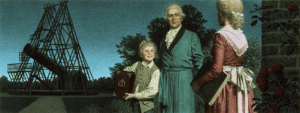In the spring 0f 1006 an object appeared in the night sky in the constellation Lupus. Its appearance was noted by astronomers across the world, and it was said to be extremely bright. By some accounts it could be seen during the day, and estimates put it at being 16 times brighter than Venus. It is thought to have been the brightest supernova to appear in recorded human history.
Despite its clear record as a supernova, a remnant of the stellar explosion wasn’t easy to find. It wasn’t until 1965 that a radio source was observed showing a circular shell of radio emissions characteristic of a remnant. It has since been confirmed as originating with SN 1006. We now know that the supernova occurred about 7,000 light years away. Detailed searches of the region find no evidence of a remaining stellar companion, so it was probably caused by the merger of two white dwarfs, making it a type Ia supernova. It is this kind of supernova that we use as a standard candle to determine the distance of galaxies.
Despite the closeness and brightness of this supernova, there were no serious effects on Earth at the time, which goes to show that much of the “Betelgeuse will kill us” hype is largely nonsense. That isn’t to say there wasn’t any effect. The supernova did cause a flux of gamma rays that left a record in Antarctic ice. This is true for other close supernova events as well, where spikes in nitrate concentrations have been found to correlate with historical supernovae.
Most recently, a new historical observation of the supernova has come to light, made by the Persian astronomer Ibn Sina. From historical reports such as these we can try to get a better understanding of things such as its apparent color and light curve. Historical observations are all we have, since there hasn’t been a close supernova in the history of modern astronomy.
Paper: Yuko Motizuki, et al. An Antarctic ice core recording both supernovae and solar cycles. arXiv:0902.3446 [astro-ph.HE]
Paper: Ralph Neuhaeuser, et al. An Arabic report about supernova SN 1006 by Ibn Sina (Avicenna). arXiv:1604.03798 [astro-ph.SR]












Comments
Interesting post, Brian. It’s fascinating to me that the antarctic ice sheet can provide a record for such things.
Typo found: “It’s appearance” should be “Its appearance”.
Yep. Thanks.
“Despite the closeness and brightness of this supernova, there were no serious effects on Earth at the time”: would that have the case if SN1006 had been a GRB with one of the jets pointed directly at us?
The main reason that Betelgeuse won’t kill us is that by the time it blows, our civilization will probably already have collapsed.
jpatrick: re: “The main reason that Betelgeuse won’t kill us is that by the time it blows, our civilization will probably already have collapsed”
Except it might have blown up 642 yrs ago (at the start of the Hundred Year’s War) and it will only reach us and end our civilization tomorrow.